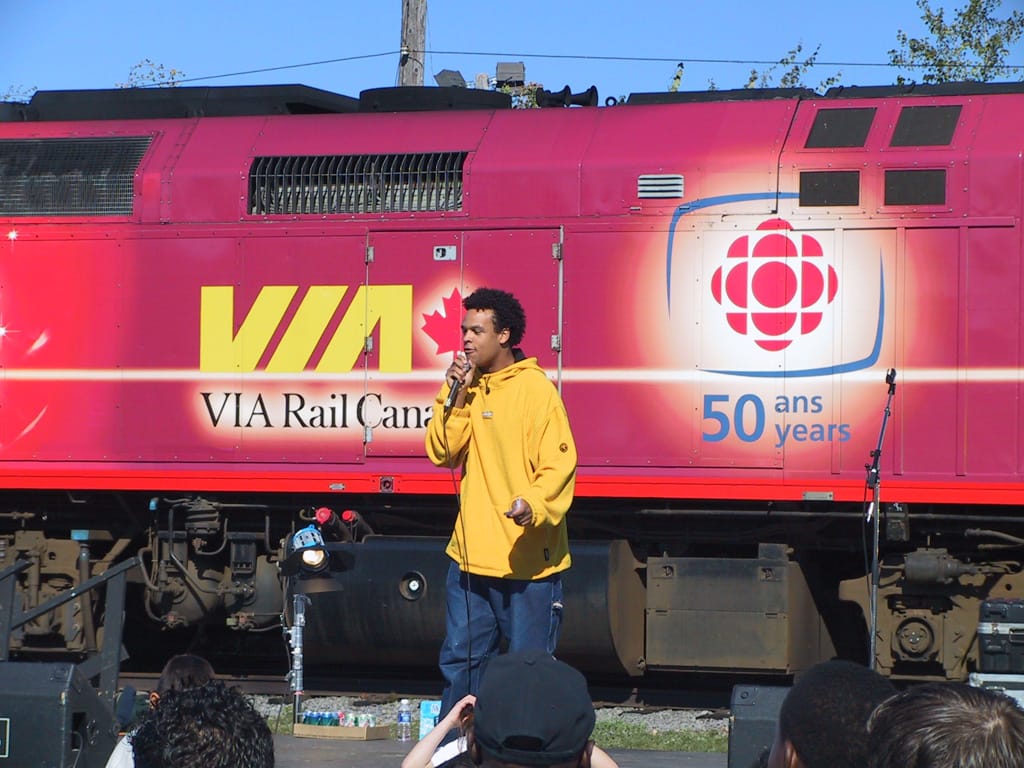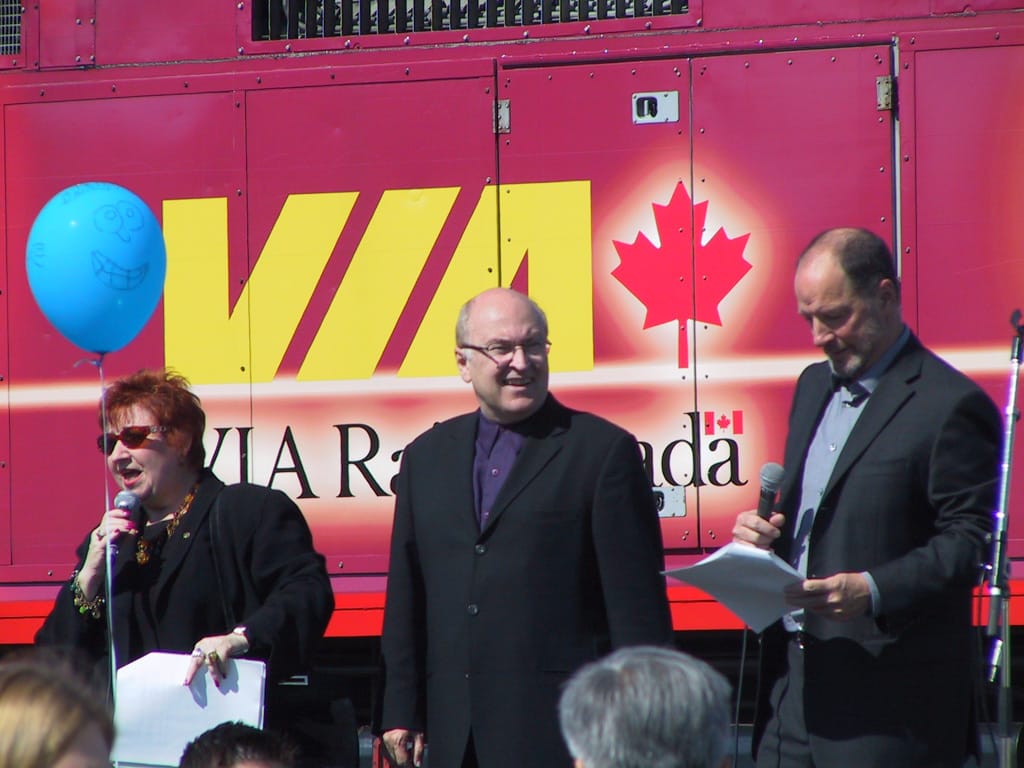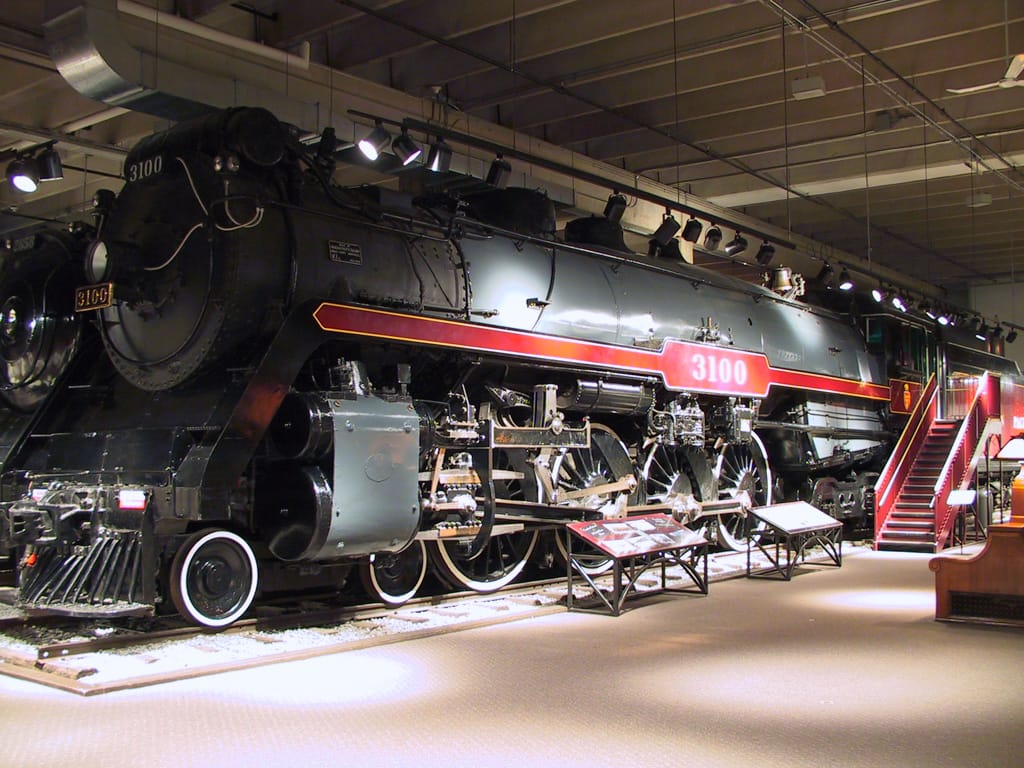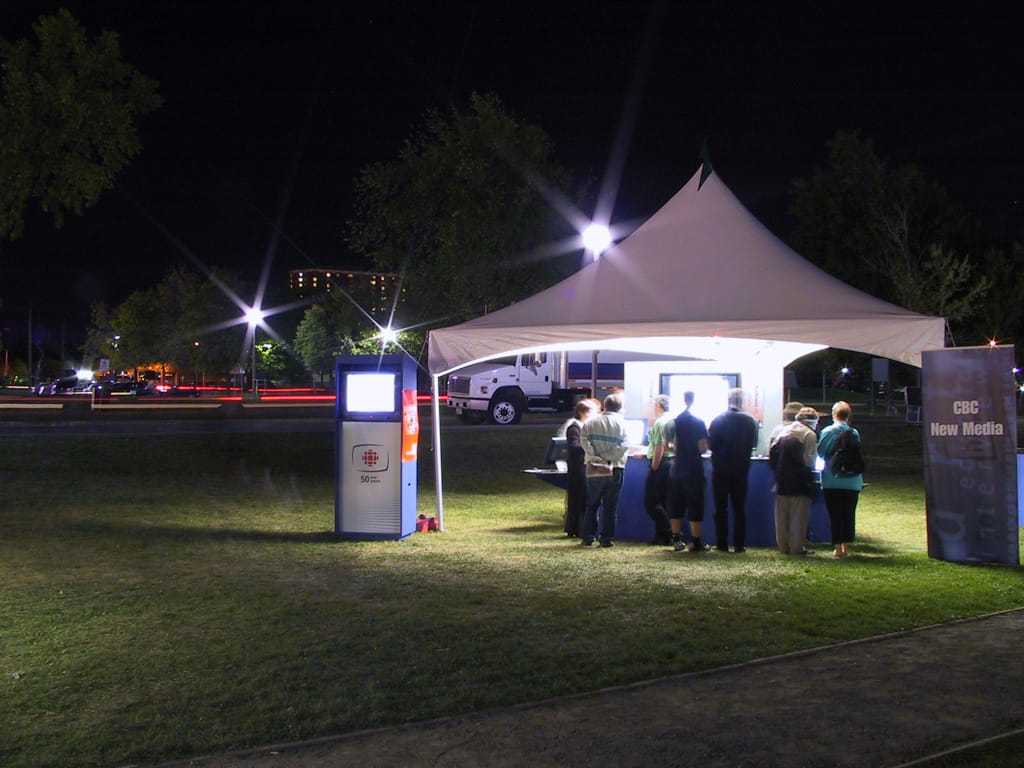Day 19
The tech crew had a really early call this morning — they were at the train long before the rest of us. They had to make sure that everything was ready with the museum cars before the schools started showing up at 08:00. We arrived by 07:30 so we could finish setting up tents and prepare for the expected deluge of people.
Terri, Elizabeth, and I began our set up almost immediately. Once shown how to set up one computer, they handled the remaining eight. That gave me time to find all the missing equipment and boxes. This is a constant problem. Although we generally pack things in the same place every time, the smaller items (the ShowVote ballots, bookmarks, pens, mousepads, and bags) have legs and are always moving around. It never fails: I always spend about 30 minutes looking for this stuff. Strangely enough, though, I kinda like it.
As the last of the computers were hooked up, three strangers arrived at our tent. Francois, Genvieve, and Christiane, from Archives at Radio-Canada in Montreal. They had come out to represent their interests and assist us with our display. Although at first confused (I wasn’t aware they were coming), I was very happy to see them. I didn’t want to travel the rest of Canada without an Archives expert, and they were all bilingual. (Ma français n’est pas bien.) And although I had put in a request to make sure I got a French-speaking volunteer, we had a problem getting any.
Apparently, Brenda did know they were coming, but because of the hectic pace at which things were set up, she simply forgot to tell me. It wasn’t a big deal — having them there was a blessing. I hate running the Archives without someone who actually knows it. Debbie was amazing at promoting the Archives — she’d make a great salesperson. Francois, Genvieve, and Christiane were also exceptionally good, and answered virtually any question someone asked. I’d be really curious to know if the traffic to the Archives site goes up as a result of this trip.
The floodgates opened when the school busses arrived. I have no idea exactly how many busses there were, but we had more children before noon than we’d had people at both our Windsor events combined. Unlike our Winnipeg event, there wasn’t the chaos. Teachers ruled their students with iron fists and kept them all in check. Busy, but manageable. Everyone went away with smiles.

Well, almost everyone. Although I didn’t encounter this woman directly, we received a complaint that we were completely unorganized when it came to children’s activities. This had all of us confused. The Children’s tent has always contained activities for children, and all of our tents are child-accessible. Unfortunately, I never heard specific faults or what we could have done better. The only thing I could think of was that someone had expected actual events, like you’d find at museums (e.g. a “scavenger hunt” for information). Emma and Stefani have enough on their hands without running something like that.
Another visitor, a former employee of CBC, had warned us of a potential flood of people starting around 17:00, when offices were out and people started rushing to see the museum. It was a wise piece of advice, although there was little we could do to prepare for it. The rush never came, though. As noon turned to afternoon, the flood turned to a steady flow, trickling off in the last two hours.
The schools had primarily brought their students to see the museum. But some schools decided to make a little more of the excursion. (In other words, they planned the activities.) One class of students, from Riverview Alternative, were embroiled in a journalism contest. They were tasked with interviewing the CBC staff for their projects. When one of them found out I work for CBC, I was suddenly surrounded by inquisitive faces.
Okay, technically, I’m only a contractor. I’m not a full employee. But for the purpose of this trip, I was told very clearly by Brenda that I am a CBC employee, and I should always say that when asked. My actual contract doesn’t say anything like that, so I can only assume it’s to keep an air of consistency. It’s fine with me. Actually, I still find it quite an honour to be asked to help Canada’s national broadcaster in such a way. It’s almost like giving back to the company that gave me so much. (Almost — I still think I’m getting more out of this than I’m putting in.)
The first student was Peter. He had a list of questions, starting included my name, how long I’ve worked for CBC, what I like most about the events we do, and if I’d ever interviewed a student before. I answered all his questions (though I answered “I’ve been involved with this project for three months”, rather than say “I’ve been with the CBC for 25 days”), giving him time to write down his answers. Being one not miss a golden opportunity, I turned the tables. (Besides, it looks good for these journals.)
Peter, like those surrounding me, was from Riverview Alternative. Not wearing my thinking cap, I neglected to ask the grade. (As I’m not a journalist, my ability to ask questions off the top of my head is a little weak. It’s a skill I’ll need to work on.) Peter’s class had come to the museum on a field trip to see the CBC 50th Anniversary VIA Rail Train. Peter was also interested in seeing who would win the journalism contest. When asked what career he was working towards, he replied, “I’m working on that”.
Bent down on one knee, I was shorter than the children surrounding me. I had hoped it would make me more approachable. Either that worked, or these kids were really keen to be interviewed.
Taking a selection at random, I picked a girl named Samah. She asked me her questions, then I asked mine. Also in Peter’s class, Samah was here to see the train. Unlike Peter, she didn’t seem too preoccupied with the contest. I added a new question this time: what have you seen so far? (I wasn’t sure if they’d been through the museum.) Samah had already been to the Children’s tent, and had particularly liked the bubble table. (She said her class would see the train after lunch.)
A forest of hands accompanied with cries of “me next!” presented a problem — too many choices. I opted for Hanady, the next nearest person. She, like Samah, also liked the bubble tables most, but had also seen the New Media displays. I was quite happy to hear that. Hanady’s wish for later life is in law enforcement.
At that point, I had to call a stop — as much as I would have loved to interview them all, it would have taken too long. Though disappointed, they understood. One last boy, whose name I regrettably did not write down, asked for an interview. Very articulate, he asked the questions much in the matter of a television interview — clearly, and with deliberate articulation. At the end, he thanked me for my time, and even shook my hand. I see a future for him in journalism.

Performances from the stage came on and off all day. This included Anthony Maclean with Infomatrix, some from Wayne Rostad with On the Road Again, and of course, Frank Leahy and Friends (which we think will be their last performance with us — though there is a little hope of them coming to Halifax). One was from the Royal Canadian Air Farce. We’ve seen them several times now since leaving Vancouver. Their energy impresses me. (Mind you, the energy of the train crew impresses me far more. The Air Farce has only been out to some of our shows. We’ve had to do all of them, yet we still smile and are as energetic with every new person as we were with the first ones in Vancouver.) But it’s getting tiring … especially Luba Goy. Her duck impression is, well, annoying. And when she’s “Really On”, she doesn’t know when to stop.

Because there were six of us manning the New Media tent, I was able to spend more time wandering around the site. Radio-Canada made an effort to bring local television talent, especially from children’s shows. It was easy to snap pictures of them interacting with children. That also set me up as a target for Radio-Canada.
I was approached by one of the Radio-Canada staff — she wanted some pictures taken, primiarly of the local talent they brought in. But then they snuck in one more thing: They wanted pictures taken of all the signs. Why? One reason (at least that we can discern): All the signs were in English. Much earlier in the project, the management team had asked Radio-Canada for input. As none was ever received, the signs were printed only in English. Radio-Canada, at least from what I could gather, was not pleased. I can only gather they wanted the pictures for evidence. The request, however, was countermanded when Rose and Julie came up to me and asked what was going on. There’s nothing like getting caught in the middle. Making a decision wasn’t too hard, though — I report to the English side of CBC.
Once the schools began to depart, the site quietened down. This allowed more time to talk to those who came to the New Media tent. All of them were so happy we had come. Three women were looking for the Royal Canadian Air Farce, and were a little disappointed to hear they’d missed hearing them on stage. A man, who couldn’t be any older than myself, was almost crushed when I wouldn’t reveal what was really inside Mr. Dressup’s Tickle Trunk. (If people only knew that it contains Duffy’s tools.)
As I wandered back from my late lunch, Daryl pulled me aside to meet a man, retired for 14 years. He has read my journals online, which brought back memories of riding in the Banff Park car, when it had been with Canadian Pacific Railway. This man was another early pioneer, having helped build the microwave network from Winnipeg to Vancouver, through the Crowsnest Pass. He seemed almost misty-eyed when telling stories of raising a 300-foot tower on top of a 3,500-foot mountain in the middle of the night, when the winds didn’t howl. Of the journey on which we are embarked, he had this to say:
“You can’t appreciate it if you’ve never seen it.”
I think this is the first real sign of a big problem we’re all going to have when we get back to “reality”. Sooner or later, we’re all going to get the question: “What was it like?” I have no idea how I’m going to answer that. We’ve done so much and seen so much that it completely escapes me how to explain it. I’m a big fan of experiences — some of my favourite trips have been insanely paced, much like this one. But they’re short, usually less than two weeks. It’s a little easier. But this is so completely beyond my abilities that I have no idea what I’m going to do. I guess the only thing I can hope for is that there will be a documentary on this.
Of the tasks I had set myself to accomplish, one was to take a picture of ex-CPR 1201, a Pacific-class steam locomotive currently housed by the museum. The last locomotive built by CP’s Angus Shop in Montreal, #1201 had been protected from the scrapper’s torch by the locomotive crews. (The story goes that when CP started looking for the locomotive, they could never find it — the crews kept moving it around and hiding it.) I wanted a photo of this locomotive. However, it’s stored in the Science and Technology Museum’s warehouse, and is not open to the public. I had hoped to eek my way through with the curator, but couldn’t connect with him in time. Serves me right for waiting to the last minute.
Instead, I settled for pictures of ex-CN 6400, the last of five streamlined Northern-class steam locomotives (sometimes referred to as Confederation class); and of ex-CP 3100, one of only two Northern-class locomotives built for Canadian Pacific. They are beautiful examples of Canadian steam locomotive engineering.

As afternoon crept along, I gave my friend Rebecca a call. Although I’d seen her and her family a scant couple of months earlier, I had hoped they might be able to come out and see the train. However, a few phone calls back and forth pretty much kiboshed the idea — too many things going on, and the traffic wasn’t really accommodating at that time of the day.
Twelve hours passes a lot faster than you might think. We had what I think was our best event yet. So many people came out to see our show, and so many walked away with memories anew and renewed. Before we knew it, the sun was setting, and our tents illuminated from the lights within. The crowds were thin. Slowly, we started to pack ourselves up.

Long days such as this can really wear one out. But though we were tired and exhausted, there was the feeling of success. We had gone through the longest day on our schedule without serious complications or complaints. There had been the odd hiccup, but nothing more serious than anything we had dealt with before … not counting Winnipeg.
When the call to break came, everyone bolted for the line of taxis waiting for us. It almost seemd a race back to the hotel, though why I’m not sure. I bade farewell to Terri and Elizabeth, as I don’t expect to see them tomorrow. It was across the street again for a post-event celebration. We’re getting good at these.
